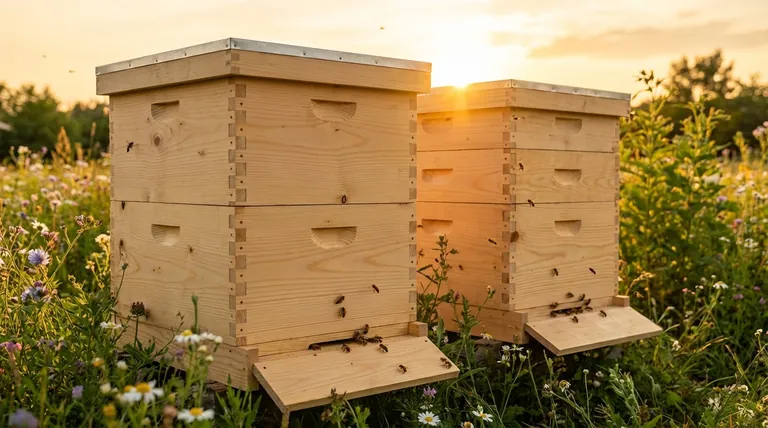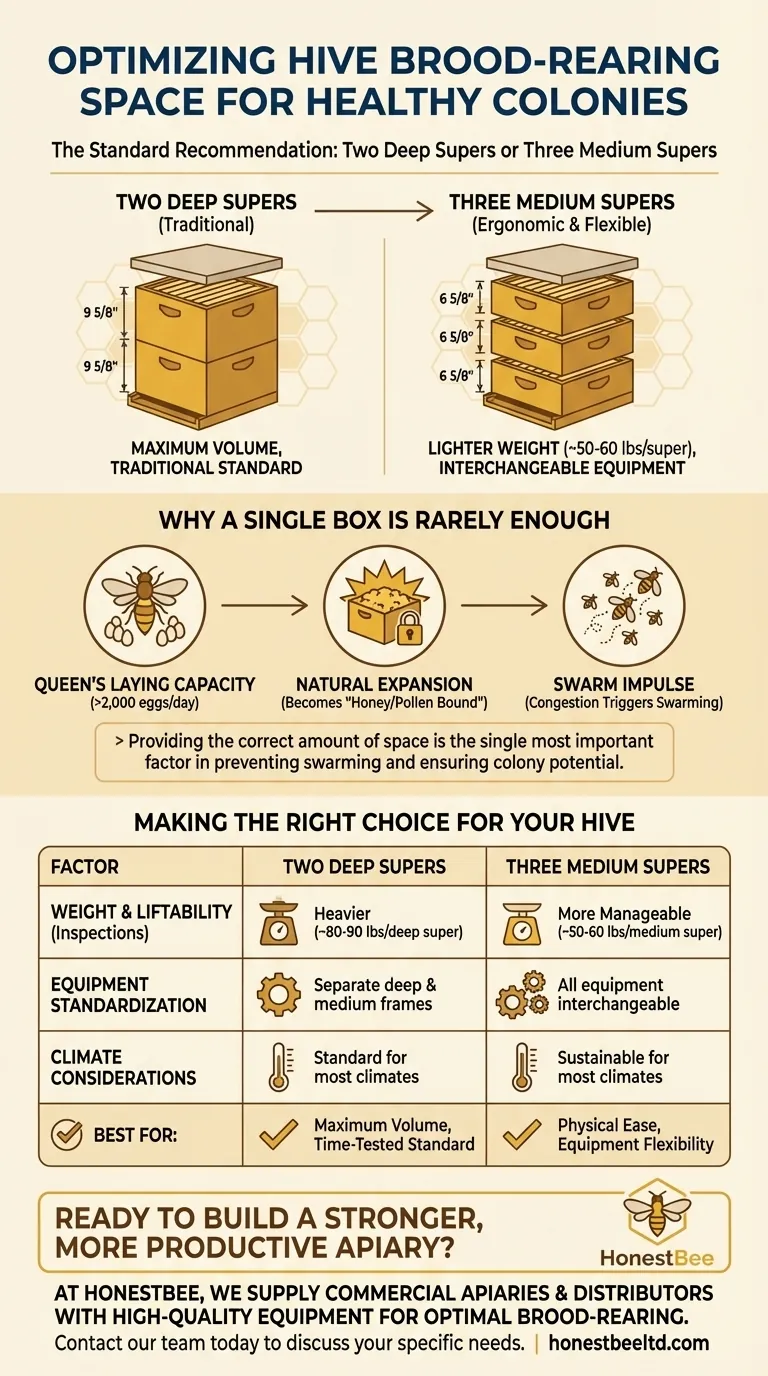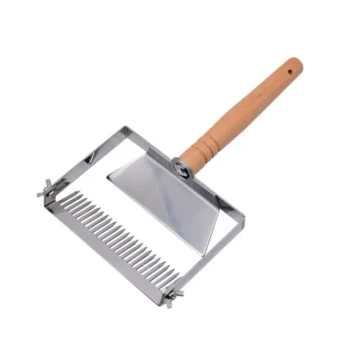The standard recommendation for a hive's brood-rearing space is either two deep supers or three medium supers. This configuration provides a healthy colony with sufficient room for the queen to lay eggs and for the workers to store the necessary pollen and nectar to support the brood. While a minimum of one deep and one medium super can work, it often proves insufficient during peak season.
Providing the correct amount of space for brood is the single most important factor in preventing swarming and ensuring a colony can reach its full potential. A crowded brood nest signals the bees to divide, whereas ample space encourages them to focus on population growth and resource gathering.

Why a Single Brood Box is Rarely Enough
A colony's population naturally ebbs and flows with the seasons. A single brood box fails to accommodate the explosive growth that occurs during spring and summer, leading to critical issues.
The Queen's Laying Capacity
A healthy queen can lay over 2,000 eggs per day during peak season. A single deep box, while containing tens of thousands of cells, must also house pollen and nectar stores, which quickly reduces the available space for the queen and can halt her egg-laying.
Natural Colony Expansion
Bees instinctively work to fill their available space. When a single box becomes full of brood, pollen, and nectar, the colony becomes "honey bound" or "pollen bound," with no new cells for the queen. This state of congestion is a primary trigger for swarming.
The Swarm Impulse
Swarming is a colony's natural method of reproduction. When bees sense they are running out of space, they will begin preparations to swarm, creating a new queen and leaving with the old one. Providing adequate space is the most effective way to manage this impulse.
The Two Standard Brood Chamber Setups
Beekeepers have largely settled on two proven configurations for the brood chamber, each with distinct advantages.
The "Two Deep" Configuration
This is the most traditional setup. It consists of two deep (9 5/8") hive bodies stacked on top of each other. This provides a vast, contiguous area for the queen to establish her brood nest and for the colony to arrange its resources naturally.
The "Three Medium" Configuration
This setup uses three medium (6 5/8") hive bodies for the brood chamber. While requiring an extra piece of equipment, it offers slightly more total volume than the two-deep setup and has significant ergonomic benefits.
Understanding the Trade-offs
Your choice between these configurations depends entirely on your management style and physical preferences. There is no single "best" answer, only the best answer for you.
Weight and Liftability
This is the most significant factor for many beekeepers. A full deep super can weigh 80-90 pounds, making inspections physically demanding. In contrast, a medium super typically weighs 50-60 pounds, a much more manageable load.
Equipment Standardization
Using all medium boxes for both brood and honey supers creates a completely interchangeable system. Any frame can go in any box, which dramatically simplifies equipment management, storage, and harvesting.
Climate Considerations
In some sub-tropical regions with mild winters, a highly experienced beekeeper might manage a colony in a single brood box. However, for the vast majority of climates, this is not a sustainable practice and risks the health of the colony.
Making the Right Choice for Your Hive
Ultimately, your decision should balance colony needs with your own capabilities.
- If your primary focus is maximum volume with minimal equipment: The two-deep box configuration is the time-tested standard for a healthy brood chamber.
- If your primary focus is physical ease and equipment flexibility: Using three medium boxes for your brood chamber makes hive inspections significantly lighter and all your equipment interchangeable.
- If you are starting with a new or small colony: You can begin with a single brood box but must be prepared to add a second one as the population grows, well before it becomes crowded.
Properly sizing your brood chamber is the foundational step to fostering a thriving, productive, and stable honey bee colony.
Summary Table:
| Brood Chamber Setup | Description | Key Advantages |
|---|---|---|
| Two Deep Supers | Two 9 5/8" hive bodies stacked together. | Maximum brood volume; traditional standard. |
| Three Medium Supers | Three 6 5/8" hive bodies for the brood nest. | Lighter weight (~50-60 lbs/super); all equipment is interchangeable. |
Ready to build a stronger, more productive apiary?
Choosing the right hive configuration is just the start. At HONESTBEE, we supply commercial apiaries and beekeeping equipment distributors with the high-quality, durable supplies needed to support optimal brood-rearing space and overall colony health.
Our wholesale-focused operations ensure you get the reliable equipment—from deep and medium supers to frames and foundations—that your business depends on.
Contact our team today to discuss your specific needs and discover how HONESTBEE can be your trusted partner in beekeeping success.
Visual Guide

Related Products
- Langstroth Honey Bee Box Hive Boxes for Different Depths
- Australian Langstroth Beehive Boxes for Beekeeping Wholesales
- Classic Drum Shaped Glass Honey Jar with Airtight Lid
- Professional 500g Sectional Comb Honey Frame System for Beekeeping
- 5 Frame Wooden Nuc Box for Beekeeping
People Also Ask
- What factors should beekeepers consider when choosing between wooden and polystyrene hives? Maximize Bee Health and Honey Production
- What are the sizes available for Langstroth boxes? A Guide to 8-Frame vs. 10-Frame & Depths
- What is the best time to inspect a hive? Optimize for Bee and Beekeeper Safety
- How should hive boxes be aligned after reassembly? Ensure a Perfect Seal for Hive Health
- What are the sizes of supers available in a standard hive? A Guide to Deep, Medium, and Shallow Boxes



















